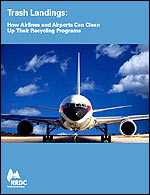Airlines Toss Enough Cans Each Year to Build Fleet of Airliners
 New York, USA - According to a new report by the Natural Resources Defense Council (NRDC), some airports and the airlines that use them are finding creative solutions that pay significant financial dividends while reducing their waste and environmental impacts.
New York, USA - According to a new report by the Natural Resources Defense Council (NRDC), some airports and the airlines that use them are finding creative solutions that pay significant financial dividends while reducing their waste and environmental impacts. “Airlines in the U.S. throw away enough aluminum cans every year to build 58 new 747s. It’s the same story with paper and plastic,” said Dr. Allen Hershkowitz, a Senior Scientist at NRDC. “Along with a huge amount of recyclable waste, the industry is away a significant amount of money. And it’s not just dollars. These are resources that don’t need to be mined, logged or drilled. And by avoiding all that, you save a lot of energy and avoid a lot of emissions.”
According to the report, the airline industry threw out 9,000 tons of plastic in 2004, and enough newspapers and magazines to bury a football field more than 230 feet deep. Nationwide, U.S. airports generated 425,000 tons of waste in 2004 – a figure expected to increase nearly 45 percent by 2015. Each passenger today leaves behind 1.3 pounds of trash, the researchers found. Seventy five percent of this waste is recyclable or compostable. Yet the industry-wide recycling rate is 20 percent or less – one third less than the U.S. average as a whole.
“Once airport managers start adding up the numbers, opportunities start becoming apparent pretty quickly,” Hershkowitz said. “The good news is that smart people in the aviation business have figured this out. Their savings are going right to the bottom line, instead of to the local landfill.”
Savings can pile up quickly – to well over $100,000 per year at each of the four airports in the study that have recycling programs. Officials at Seattle-Tacoma International Airport, perhaps the nation’s leader in airport recycling efforts, say they are saving almost $180,000 annually – with more yet to come. Baltimore-Washington International Airport (BWI) cut costs by approximately $15,000 a month.
Because it takes a lot less energy to use recycled rather than virgin resources, better waste strategies offer significant savings in energy and emissions, too. If airports and airlines matched the average U.S. recycling rate, it would save enough energy to power 20,000 U.S. households. Heat-trapping carbon emissions responsible for global warming, equivalent to the pollution from 80,000 cars, would be eliminated.
NRDC looked at 30 airports around the country, and found that most are leaving money on the table. The study identifies opportunities and barriers, and spotlights top performers as examples for other facilities to follow. The answers may be as simple as centralized waste collection, and better contracting strategies.
Seattle-Tacoma International Airport (Sea-Tac) uses both conventional and creative ways to cut its waste. For example, airport vendors generate up to seven tons of used coffee grounds each month (not surprising in America’s coffee capital). Airport managers discovered they could cut costs 75 percent – $60 a ton – by sending the leftovers to a compost facility instead of the dump. Sea-Tac also sends 1,000 gallons of used cooking grease each month to a company which makes it into diesel fuel, saving the $100 a ton it cost for disposal at a rendering plant.
Since bringing on a new waste management contractor with an eye toward recycling in 2001, the amount of waste diverted for recycling has increased by 800 percent – from 100 tons in 2000 to 900 tons in 2005. The amount of material recycled at Sea-Tac increased from 112 tons in 2000 to 700 tons in 2004 and reached 900 tons in 2005.
By putting all its waste up for bid under one contract and by increasing its recycling efforts, the airport authority in Oakland, California has been able to negotiate lower waste management fees for the airlines. Costs have decreased for one airline from $7,700 per month to $2,500, and another airline’s monthly costs have dropped from $2,300 to $1,000.
Under Oakland’s new, centralized system, not only is recycling available to the airlines and airport tenants, but, according to airport personnel, the savings from adopting a larger waste disposal and recycling contract are so substantial that airlines have seen their monthly waste disposal bills drop by more than 50 percent.
Southwest Airlines allows the local staff at Oakland International Airport to keep the revenues generated from the sale of recyclables to fund employee barbecues, special events and a discretionary “rainy day” fund for employee assistance. The airline saves money by avoiding waste disposal fees, and the employees benefit as well.
These are just a few of the examples listed in the report, which provides case studies and a comprehensive reference for other airlines and airports to begin taking advantage of similar savings opportunities.
For more information on the Natural Resources Defense Council (NRDC), please click here.
You can return to the main Market News page, or press the Back button on your browser.

